
Miyamoto Fujie & Miyamoto Jitsuo
The Rōya no Sako "Narrow Jail" Incident
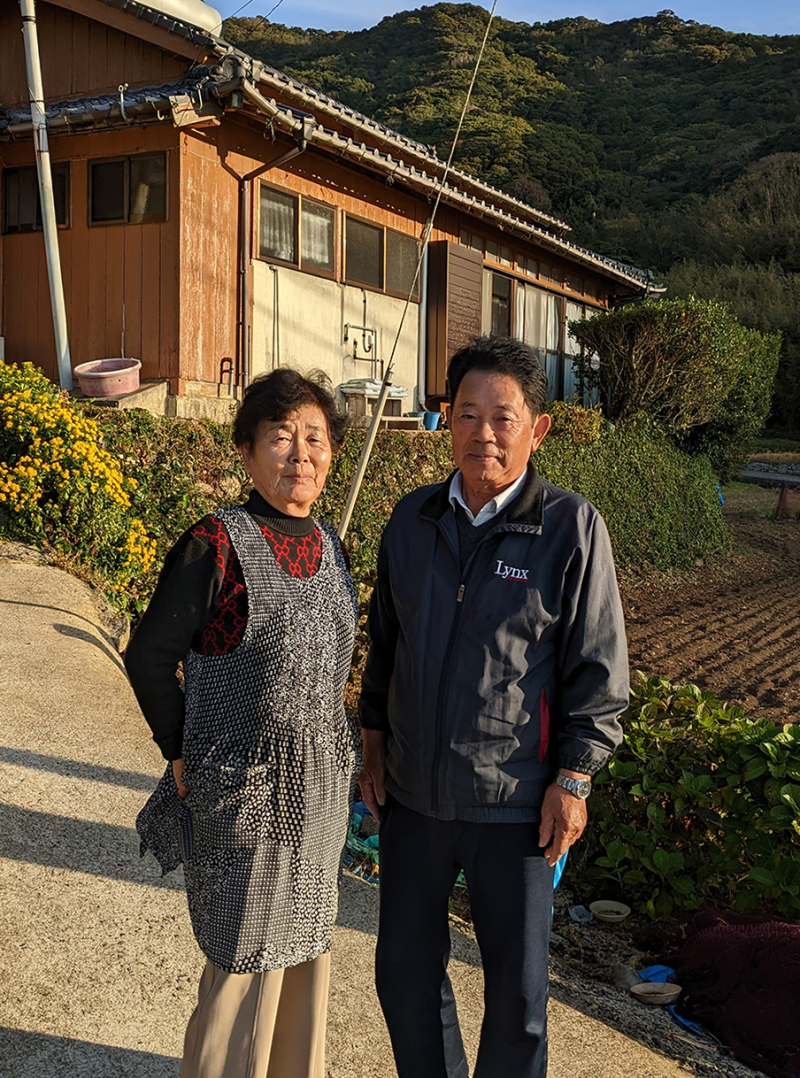
Date:
17 November 2022
Location:
Hisaka Island, Gotō Islands, Nagasaki Prefecture
Excerpt Length:
Approx. 14 minutes
Participants:
Interviewer: Gwyn McClelland (GM)
Interviewee 1:
Fujie Miyamoto 宮本フジエ (FM)
Born Sotokami-chiku, Tanoura-chou, Hisaka Island, Shōwa 25 (1950). 72 years old at time of the interview.
Interviewee 2:
Jitsuo Miyamoto 宮本實男 (JM)
Born Inokicho, Eiri, Hisaka Island, Shōwa 21 (1946). 74 years old at time of the interview.
Below is the transcript plus audio of an interview recorded on the Gotō Islands. Oral history consists of spoken memory. As it is personal opinion it is in no way intended to present the final verified or complete narrative of events. You are free to use the material in this transcript for research and study, education, other non-commercial or non-public purposes. You must not at any time do, permit, or authorize any act that infringes the copyright in the material. (e.g. By reproducing, publishing, performing, communicating, adapting, or entering into a commercial rental arrangement, or authorizing a third party to do any of those things). Requests for further rights in respect of the materials (such as a right to publish, reproduce, broadcast or perform) may be made to Japan Past & Present.
English Transcript
To switch to the Japanese-language transcript, toggle the EN/JP option in the webpage's main menu.
[Section 1: Martyrdom and Torture]
Gwyn McClelland
So, er, well, what is an important place speaking in religious terms?
Fujie Miyamoto
[immediately] It's got to be Rōya no Sako. [literally: "The Narrow Jail"]
Jitsuo Miyamoto
[agreeing] [In terms of religion], the most important place is Rōya no Sako, where there was a martyrdom. [GM: I went there today.] Where I was born as well, there used to be a place called Eiri Church. Eiri Church.
Jitsuo Miyamoto
Basically, on Hisaka Island there used to be five different churches. When there were the most [people] here. Hamawaki Church [still exists today]. Eiri Church, Zazare Church [no longer exist]. And in the area called Oobiraki there was Akatani… Akanita Church [no longer exists], and then Gorin Church [you can visit but it is no longer a living parish]. Now it is called the "Old Gorin Church" but before it used to be the Gorin Church. And so there were five places. Among them, I went to Eiri Church. And it was a junkai (Circuit) Church [in other words, no priest in residence], though.
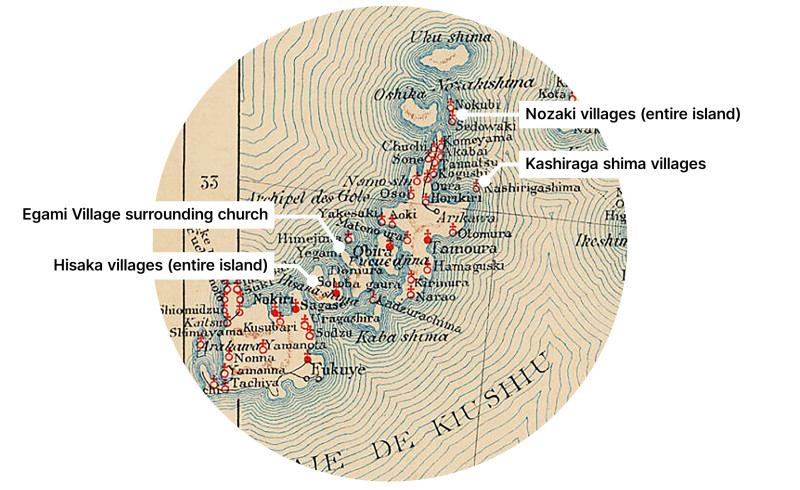
Gwyn McClelland
Okay, so is it okay if I ask about the martyrdom? Do you mind? I know (as I recently came from Naru Island) that for the people from Naru Island, there was some [trouble] on Kashiragashima⋆ but, really, more than Naru, I hear that it was worse on Hisaka Island and when you go [to the martyrdom site] it is awful isn't it. I know it is a difficult thing, so have you heard a lot about it for a long time? Have you heard a lot about it since you were children?
⋆ [The interviewer meant to say Kazura-shima near Naru]
[silence]
Fujie Miyamoto
[He is asking] about Rōya no Sako. [JM: Hm, let me see… ] It is written down over there. On the stone monument. Beside the monument, on the signboard.
Jitsuo Miyamoto
Oh, they wrote it on the stones [FM: the martyrs] on the stones the martyrs…
Gwyn McClelland
The names of the martyrs and their ages?
Jitsuo Miyamoto
No, …
Fujie Miyamoto
Well, if you go up where you enter from the stairs, there is an explanation. The explanation was written there.
Gwyn McClelland
Ohhhh, right.
Jitsuo Miyamoto
Yes, in the first year of Meiji era, more than two hundred people were put in the jail⋆, and so on… I learnt about it from when I was small, and at first I heard from my parents.
⋆ Correction made to interview here where Jitsuo pointed out he had said more than people died, but he meant more than two hundred were put into the jail.
Fujie Miyamoto
That is where mizuzeme, sangiseme is written about you see. The water was forced into their stomach, and then when there stomach was full, then they would press their stomachs until they spewed it out. And they did this over and over.
[See the references to mizuzeme and sangizeme in the vocabulary list.]
Jitsuo Miyamoto
They were tortured in various ways. And we heard all about it from when we were small, first from our parents. After that we read books about it, and to a degree we were forced to. It was that kind of feeling. We first heard it from our parents…
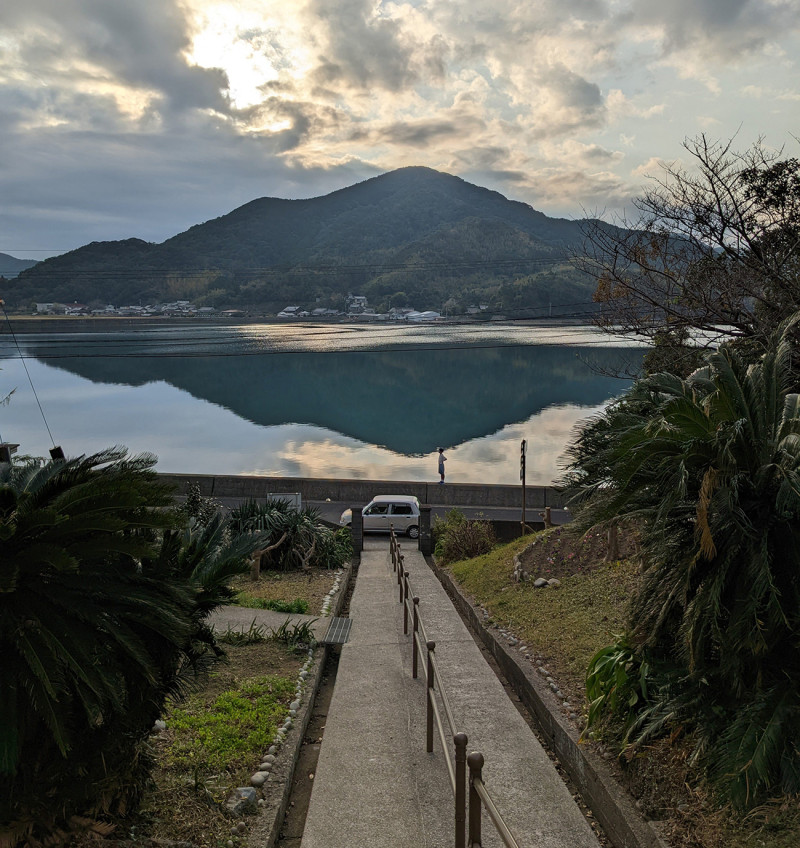
[Section 2: Some Kirishitan Were NOT Put in the Jail]
Gwyn McClelland
As Jitsuo-san said before, for this church, was the persecution that bad?
Jitsuo Miyamoto
?
Fujie Miyamoto
That church, more than the church, [the magistrate] built the jail in a place where the watchpeople could see what was going on. The guards. Tomorrow, you are going to Fujiwara-tei [a renovated old town house] aren't you. Fujiwara-tei is where the bannin [watchpeople] used to live. They built the jail so that it could be seen from there. [JM: Saying, they built a jail] So, there did not used to be a church there.
Jitsuo Miyamoto
At Rōya no Sako. There was not a church there.
Gwyn McClelland
Ah, there wasn't before. But, so that you can remember it, [it is there today].
Fujie Miyamoto
[…] by the land/place […] Yes, that is right.
Gwyn McClelland
Ah, I see. You still really feel it don't you.
Fujie Miyamoto
[unclear comment… silence]
Jitsuo Miyamoto
Hm, saying that, yes, persecution, basically, for me, for her [Fujie] her ancestors were put in the jail, but my ancestors were actually, just like the others they were Sempuku Kirishitan and they came from Sotome area [north of Nagasaki city] but my own ancestors were not put into that jail. And the reason they were not put into it is that actually, at the Fukuwara house, what is today the Fukuwara house was at the time, at the disposal of the Lord of Fukue Island. So the samurai, he was a "country" samurai at the time, and for example if someone was a criminal, or did something bad, they were put into a jail, or they would make a temporary jail where they would put them.
In those days, sugar, and salt, and rice and other things were rationed you would say, it was that kind of situation. And that was what the Fujiwara-tei brought to Hisaka Island you see. The Lord of the Gotō distributed them so… lots of things! Because of that, when you wonder why my ancestors were not put in the jail, it was because they were "busy bees" [hard workers], you could say, my great-grandfather I guess, or my great-great-grandfather -yes, my great-great-grandfather I think, who was in his thirties at that time, and a vigorous worker. And, getting the peasants to do various things, so rather than putting them in the jail, it was better to let them work, so they put them to work.
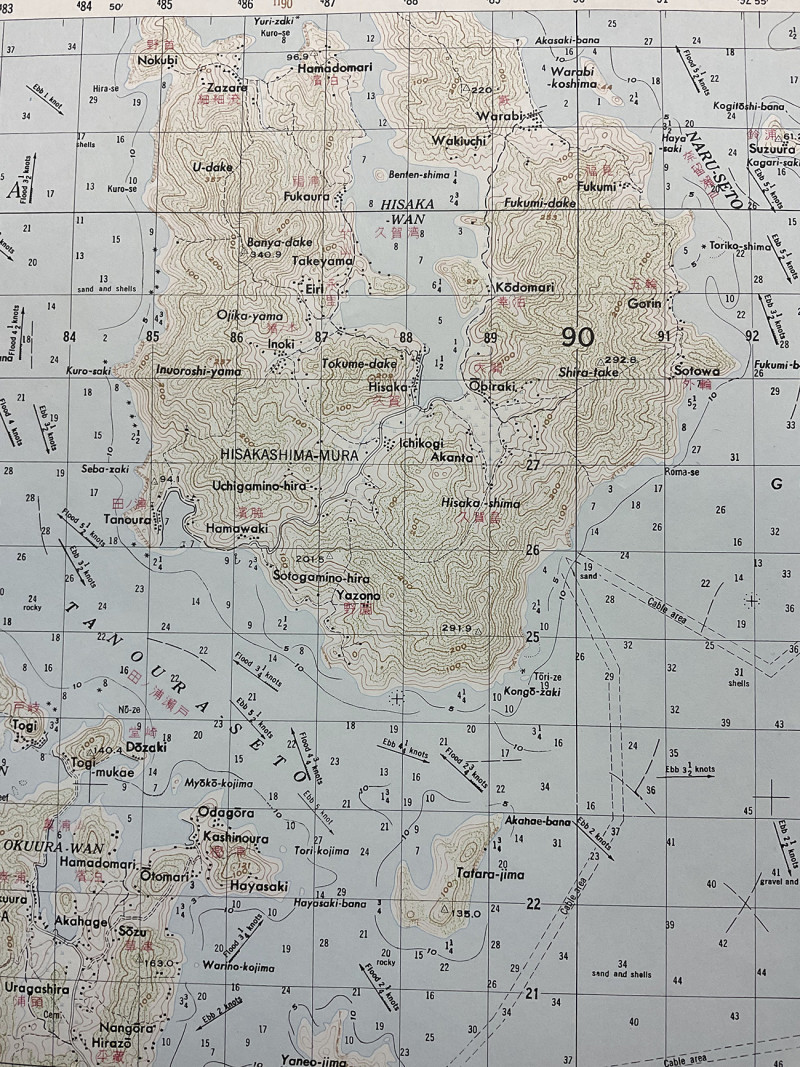
Gwyn McClelland
So ignoring what they were doing… they continued on.
Jitsuo Miyamoto
Yes exactly. Not putting them in, not putting them in the jail, and making them work, but they were still tortured at home. Usually, [it happened] at the main pillar of the building… ]
Gwyn McClelland
[confused] The household head, so, wasn't he over there? Wasn't it across the way? Was the household head the daikan's…?
Fujie Miyamoto
He means the daikan…
Jitsuo Miyamoto
The daikan: Fujiwara-tei is the place they served and visited as well. That is where you will go tomorrow. It is now the "Exchange Center" though.
Fujie Miyamoto
And, that is where his ancestors [Jitsuo's] worked, you see.
Jitsuo Miyamoto
So, my family could not be put in jail, because they were being used as workers. Most families, those who were Sempuku Kirishitan and on Hisaka Island were put in the jail. [GM: So most people were put in the jail at the time, but…] But my ancestors were also Sempuku Kirishitan but they were just not put in.
Gwyn McClelland
So that was rare.
Jitsuo Miyamoto
Exactly, it was basically the people living in Eiri. There were quite a few who lived in Eiri who were spared from being jailed.
Fujie Miyamoto
But there were some other people who were not put in [the jail] because they rejected Catholicism, I think. Then later when the kinkyōrei (ban on Christianity) was done away with, they returned, and became Catholics again. Even though others kept their faith.
Gwyn McClelland
I see, I see. Really?
[Section 3: Memorializing Rōya no Sako]
Gwyn McClelland
So, Fujie's ancestors were taken away (and jailed) and then, did you hear anything about that? Or … basically, was…
Fujie Miyamoto
So, after they were put [in jail] at the Rōya no Sako site: On the commemoration stone, my ancestors' remains that were dedicated there were remembered, that is what I heard…
Gwyn McClelland
Right, I see. So, you know who they [your ancestors] were don't you?
Fujie Miyamoto
As for a name [laughs], I didn't try to memorise it, so I don't remember. It was written as Nakayama someone… [Fujie's maiden name] [laughs]
Jitsuo Miyamoto
Basically, at the 100th year anniversary of the martyrdom, at the time in Hisaka Island, of those people who had been remembered for being put into the jail, within the persecution, for example, if their name was not written on the memorial we didn't know it, and so it was only the ones written on the memorial at Rōya no Sako – that is where you went, to Rōya no Sako, didn't you? When you go there, [behind] within the bas relief, there is an ossuary there. Within the ossuary, it is just the people we know about whose remains are included. Gathered together. I think it is basically ten names… [that are included]. Ten people. Just ten people we knew. There were forty-two or forty-three people who were martyred, and only ten of them have their remains enshrined in this place.
Fujie Miyamoto
Originally, the family names were not at first included were they?
Jitsuo Miyamoto
Yes, the family names were not there at first. Yes.
Gwyn McClelland
Were you able to understand that at the 100th anniversary?
Jitsuo Miyamoto
Yes, just the people we knew of. Well, basically most people did not have a memorial stone raised then and, as it was the first year of Meiji era even if there had been a stone, because it was sandstone, or whatever, the writing would disappear. So, there were absolutely many people we didn' know about, among the forty people, we only knew of ten [definites], so we dug up their graves again by digging in among various gravesites from which they were buried, digging up again, in order to enshrine them in the Rōya no Sako site.
Fujie Miyamoto
[quietly] It was Masagorō. [JM: Masagoro?] Definitely, Masagorō was his name, my grandfather was known as Masagorō, his common name. Kami no Hira.
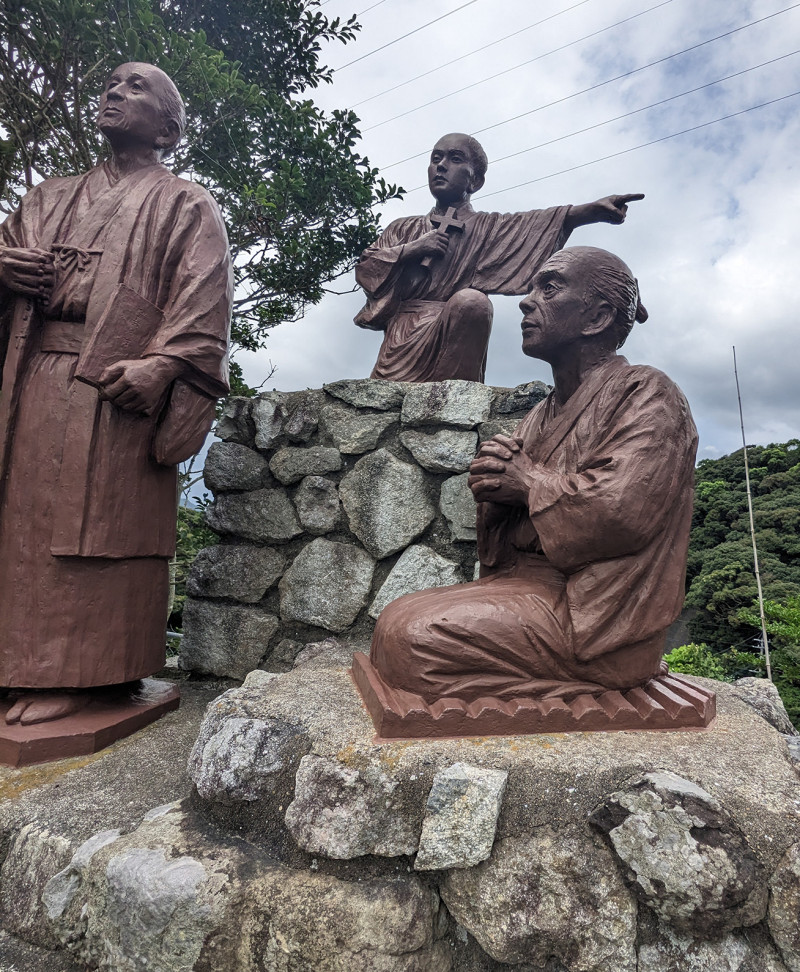
[End of Interview Excerpts]
Suggested Citation:
Miyamoto, Fujie and Miyamoto Jitsuo. "Miyamoto, Fujie & Jitsuo: The Rōya no Sako "Narrow Jail" Incident." By Gwyn McClelland. Hidden Christian World Heritage in the Gotō. Japan Past & Present (17 November 2022).